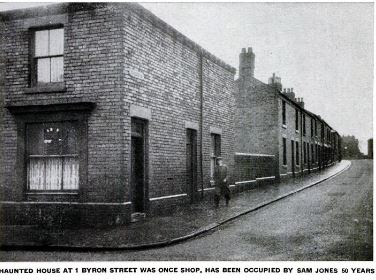It’s not often that a ghost story could be called “sweet,” but that adjective arguably applies to this odd, and oddly touching, little tale. It was first published in folklorist Mary L. Lewes’ 1911 book “Stranger Than Fiction.”
The backdrop for our story is a large old estate called Wernafon, which stood in what Lewes called “one of the most peaceful and beautiful spots in Wales.” Wernafon was surrounded by oak woods, flowery meadows, and a clear, meandering river, so Lewes was probably not exaggerating in the least. During the rainy season, the normally quiet river flooded stepping-stones and fords, so, for the sake of Wernafon’s workforce, and anyone else who lived on the other side of the river, a narrow wooden foot-bridge was built.
Among Wernafon’s residents were two laborers whom Lewes called merely “Ben” and “Tom.” The two had known each other since boyhood, and were the closest of companions. The day eventually came when “both being old” Ben died. Tom was naturally left stricken and terribly lonely by the loss of his longtime friend.
One day, soon after Ben’s funeral, Tom was crossing the river’s foot-bridge, full of sad thoughts. He had imagined himself to be quite alone, so he was startled when he suddenly saw a man standing before him in the middle of the bridge. When he looked at the figure more closely, he realized that it was Ben, giving him a friendly smile of welcome. Ben looked so natural, Tom forgot entirely that he had last seen his old friend being buried six feet under. The two exchanged a bit of casual chit-chat about trivialities, and then Ben asked Tom a curious question: Would he like to see the inside of Wernafon? Ben explained that “I go there every night, and a strange sight it is to see the people all asleep while I pass through.” He said that if Tom would meet him on the bridge at midnight, he would give Tom a guided tour. Then, Ben silently glided over the bridge, and disappeared.
It was only then that a feeling of cold horror came over Tom, as he realized that he had just been talking to a dead man. He told himself that he had merely been seeing things, or had an unusually vivid dream. However, Tom was a brave man, and besides, he was intensely curious to see what would happen if he kept the suggested rendezvous. That midnight found him standing on the bridge, awaiting events. He soon saw that Ben had again appeared at his side. After giving Tom a cheerful greeting, Ben took him by the hand and led him to Wernafon’s front door. The door was, of course, securely locked, but the lightest touch of Ben’s hand caused it to quietly swing wide open for themselves. Ben led Tom through the dark, silent house and up the staircase.
When they reached the landing, Ben stopped in front of a closed bedroom door. It immediately opened. When the pair softly walked in, Tom noted that the room was filled with a strange bluish light. They stood for a moment gazing at the sleeping occupant, and left. Ben and Tom visited all the other rooms in the same fashion. Eventually, “how he hardly knew,” Tom realized he was back in the moonlight outside the front door. And Ben had disappeared.
Poor bewildered Tom walked home, hardly knowing how to comprehend what had happened. However, he probably did not have to wait long for enlightenment. Only a few days after his strange experience, Tom suddenly joined his old friend in the grave.
So, sleep tight tonight. Ben and Tom may be watching over you.
[Note: “Wernafon” may have been Lewes’ pseudonym for the estate. However, there was once a “Wernafon colliery” in West Glamorgan and in 1841, a field in Merionethshire was recorded as being named “Wern afon.” Perhaps the house had a connection to one of those sites.]



















